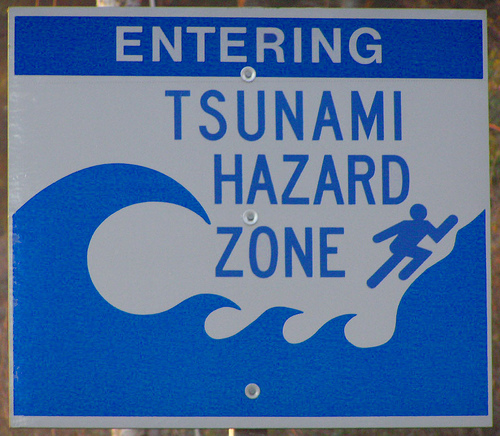Published on
The Coming Campus Tsunami and the Business of Education

In “The Campus Tsunami” —one of the most talked about columns in recent memory in my circles—award-winning NY Times columnist David Brooks alerts us to the coming storm: in a dramatic exercise in understatement Brooks offers this prediction: “What happened to the newspaper and magazine business is about to happen to higher education: a rescrambling around the Web.”
To get what Brooks is fussing about, you will need to recall what your locally-held or family-owned newspaper looked like in 1999 and compare it with what you read today. Oh, you don’t get a newspaper, and don’t read one except on-line? Then you too get Brook’s point. The newspaper business illustrates what a digital tsunami can do to an industry in its path. Does the same fate await bricks-and-mortar higher education?
This is not the first time in recent memory that a dangerous storm seemed to be approaching the bricks-and-mortar university: In 2001, Columbia University announced a commercial venture to export learning to the web that involved the University of Chicago, the University of Michigan and others. Not long after Yale, Princeton and Stanford announced their own collaborative initiative, supposedly tolling the death knell of the traditional university classroom.
Both ventures are now long-dead and gone.
Reading Brooks’ column, I was reminded of Twain’s old, oft-repeated saw, “Reports of my death are greatly exaggerated;” and, I’ve noticed since that critics of on-line learning like to strike back at the likes of Brooks with their own obits for—or perhaps I should say “exaggerated reports of”—the death of the On-line Ed option. Hubert Dreyfus, writing his preface to On the Internet (Routledge, 2009 2nd edition) proclaims that “It is now clear that distance learning has failed.” Instead, in Dreyfus’ view, we stand on the cusp of a blended e-learning/classroom-learning revolution, and the “embodied classroom” is here to stay.
Right or wrong, however, Brooks has gotten me thinking. With the gap between smart people like Brooks and Dreyfus looming before the rest of us so menacingly, how can we possibly know where the academy-as-a-physical-space will be in a decade, literally and metaphorically?
It was in this state of perplexity that I encountered Margaret Wente, an award winning Canadian journalist focusing on higher education. Wente was recently interviewed (see: Disruption on the Horizon) on The EvoLLLution, an on-line newspaper “by and for those who know higher education best.”
What I think will strike almost any reader—or listener as an audio file of Ms. Wente’s interview is attached to the article—is her bold and unapologetic business demeanor. Witness her words—the logic and jargon—of a hard-nosed market-player demanding value in the marketplace.
“The value proposition of higher education is changing very quickly…
There have been devastating, devastating studies recently about what value university does or doesn’t add…universities in fact don’t teach students, on the whole, to think more critically. [They also] don’t teach them to become better writers and thinkers. And that value [which] everybody assumes gets added really doesn’t get added at all. So there’s again, another instance where the value proposition is breaking down.”
Wente is especially enthusiastic about assessing the state of higher education as a question of its “value proposition,” textbook economic jargon, and, the value to society of the bricks-and-mortar college is not high in her estimation. It would be fair to say that she’s looking forward to a digital revolution which will overthrow the liberal arts college and its disengaged tenured professoriate.
Does her business stance fit the higher education context? What is the value of her value-proposition talk to those of us working in the field?
Let’s consider that a value proposition is a claim, made by an interested party, and proposed to a marketplace for its consideration. Everyone knows it’s designed to entice. Nike offers you shoes distinguished by fit and comfort. Dunkin-Donuts: the right taste at the right price. And liberal education? According to Wente, liberal education is a product-poor business, trying to pass off its sack of rotting potatoes to the benighted public, and at fresh food prices no less.
But is that how it really is? Let me offer a different perspective by reminding readers of another recent debate not at all unrelated to the one about the digital revolution in higher education. I’m talking about the vigorous discussion in the 80s and 90s about public schools, about the schools “we need, and why we don’t have them,” to quote a key player in this debate, E.D. Hirsch. If anyone had suggested in the heyday of this debate that the answer was to “go on-line,” they would have been laughed out—or thrown out—of the room.
This glancing comparison, limited in value though it is, points to the problem with Wente’s value-proposition talk, and raises the question of whether, business bravado aside, Ms Wente, and people like her, are too quick to rely on marketplace jargon in their analysis. Yes, many colleges and universities that promise a liberating education fail to deliver the value they have proposed to the market place, but their failure does not undercut their value proposition. On the contrary: the problem is with the production and distribution of educational value, but not with the value as proposed.
The value proposition of a liberal education stands—this was, in fact, the one point of consensus underlying the contentious debate of the 80s and 90s between Theodore Sizer and E.D. Hirsch and others.
What Sizer and Hirsch understood, but people like Wente ignore, is that Johnny cannot read, write, or count. Even college-bound Johnny. More recently, the desperate situation of American high schools, especially urban schools in poor districts, has led author Doug Lemov, an MBA from Harvard Business School, to argue that everything teachers do in the classroom should be measured against the value they could achieve simply by having students read (and the same point could be made with respect to counting and writing as well). Taking a page from finance, he calls this the teacher’s “hurdle rate.” I invoke Lemov because he also prefers the nomenclature of economics. Yet, read Lemov’s Teach Like a Champion; you will not find a single page dedicated to the digital revolution.
The phenomenon Ms. Wente’s recent salvo represents is too prevalent too ignore. David Brooks is right—higher education is in the middle of a storm, and, in due course, it will indeed be remade. As we attempt to cope, let’s not hide behind the jargon and bravado of business and economics. Mr. Lemov, Harvard MBA on the wall, teaches us that the value we propose to the marketplace, whether at the secondary, collegiate or life-long learning level, is literacy and numeracy—plain and simple; or perhaps better, it is against this simple standard that we ought to judge what we actually propose.



